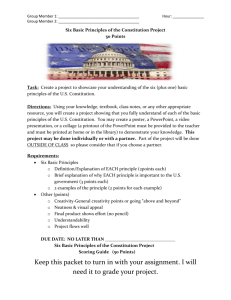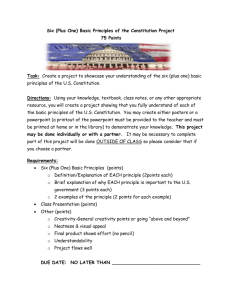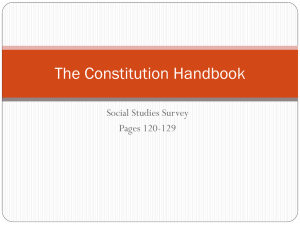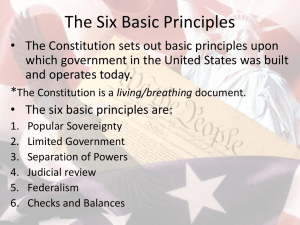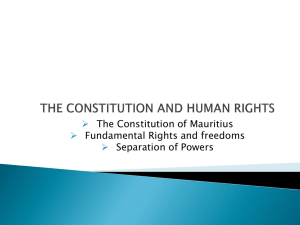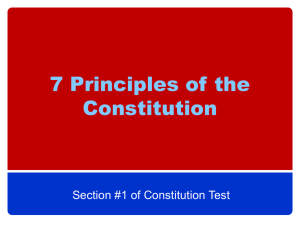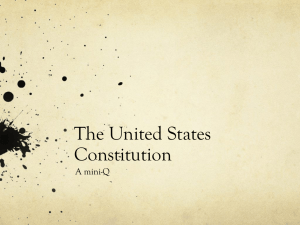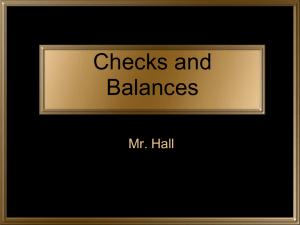Fear of a tyrannical government overpowering the liberty of the
advertisement
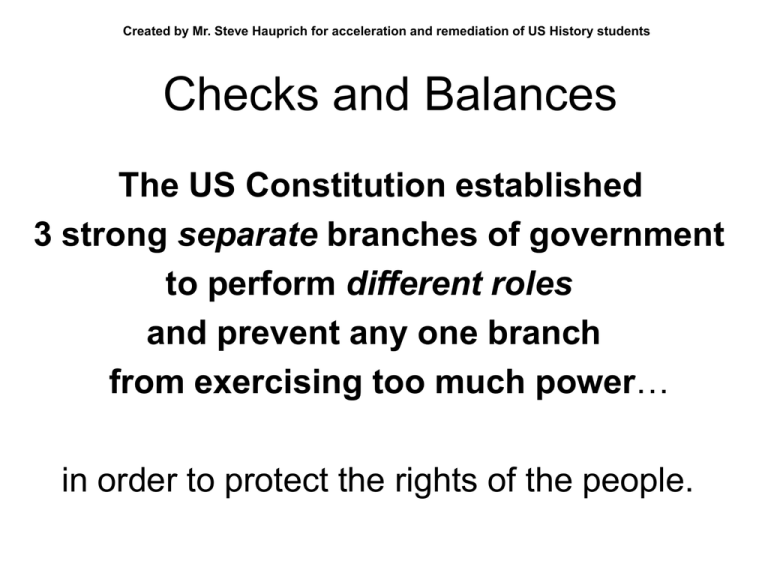
Created by Mr. Steve Hauprich for acceleration and remediation of US History students Checks and Balances The US Constitution established 3 strong separate branches of government to perform different roles and prevent any one branch from exercising too much power… in order to protect the rights of the people. Fear of a tyrannical government overpowering the liberty of the people was a major reason for including Separation of Powers with Checks and Balances to the US Constitution. An uncontrollable ruler !?! The executive branch would be led by a powerful leader called the President of the United States of America. Would the new US President be too powerful ?!? The Legislative Branch (House of Representatives and Senate) has the power to declare war, raise taxes, and create new government agencies. Would the Legislative Branch be a powerful two headed monster?!? The Judicial Branch would consist of 9 Justices appointed for life to decide the power of the government and rights of the people. Would Americans be protected by their 9 powerful Justices?!? The answer to all these questions is the government would consist of ordinary people trying to represent their fellow citizens… working hard to protect rights and freedoms. Ordinary people defending basic American freedoms = liberty + justice for all At times in US History Presidents have taken strong actions to save the nation, Congress has declared wars, and the Supreme Court has limited the powers of the other branches. All of these actions were made possible by the authors of the US Constitution when they established 3 strong branches of government. ___1. The lack of a national executive and judiciary under the Articles of Confederation suggests that the founders of the American republic (1) risked tyranny for the sake of effective national government (2) copied the British constitution (3) prized national unity above the sovereignty of the states (4) feared a strong central government “. . . it is the opinion of this committee that a national government ought to be established consisting of a Supreme Legislature, Judiciary, and Executive. . . .” — Resolution submitted by Edmund Randolph, delegate to the Constitutional Convention, 1787 ___2. In adopting this resolution, the framers of the Constitution showed their belief in the idea of (1) judicial review (2) an elastic clause (3) States rights (4) separation of powers ___3. Which action would most likely result in the greatest increase in the power of the executive branch? 1 abolishing the electoral college 2 borrowing money from the World Bank 3 broadening the President's wartime authority 4 lowering the age at which a person can be elected president ___4. The President of the United States can influence the judicial branch of government by 1 removing members of the Supreme Court 2 choosing the chairperson of the Senate judiciary Committee 3 nominating Federal judges who support his programs 4 requiring the Supreme Court to declare certain laws unconstitutional ___5. Which action illustrates the president’s power as commander in chief ? (1) ordering American troops into a foreign country (2) appointing the secretary of state (3) entertaining a foreign leader at the White House (4) delivering the State of the Union address ___6. Which headline best illustrates the system of checks and balances? 1 "Senate Rejects Supreme Court Nominee" 2 "State Legislature Fails To Adopt Budget on Time" 3 "Congress Votes To Reduce Income Taxes" 4 "United States Peacekeeping Troops Sent to Bosnia" ___7. Which governmental action illustrates the system of checks and balances? (1) a senator helping a governor solve a state problem (2) the president negotiating a trade agreement with foreign diplomats (3) the Senate ratifying a peace treaty (4) Congress raising taxes to pay for federal programs "The accumulation of all powers, legislative, executive, and judicial, in the same hands ...may justly be pronounced the very definition of tyranny.“ ___8. The writers of the United States Constitution intended to prevent the situation described in this quotation by 1 developing a system of checks and balances 2 relying on an electoral college 3 establishing political parties 4 including the implied powers clause ___9. A system of checks and balances was included in the United States Constitution because the authors were concerned about (1) one branch of government becoming too strong (2) the states having too much power (3) the people having a voice in government (4) the military gaining control of the United States "President Roosevelt Proposes Wide Range of New Deal Programs" "Supreme Court Orders President Nixon To Release Watergate Tapes" "Congress Calls Cabinet Member To Testify“ ___10. Which concept is best illustrated by these newspaper headlines? 1 federalism 2 state rights 3 the elastic clause 4 separation of powers "There can be no liberty if the same man or the same group has executive, legislative, and judicial control.“ ___11. Which political idea would the author of this statement most likely support? 1 States rights 2 separation of powers 3 socialism 4 federalism ___12. Which aspect of the American political system was most influenced by the ideas of John Locke and Baron de Montesquieu? 1 executive control of foreign policy 2 limitations on the power of government 3 government regulation of the economy 4 creation of the electoral college ___13. The creation of the first political parties in the United States resulted from a controversy over 1 declaring independence from Great Britain 2 recognizing women's equality 3 expanding slavery into the newly acquired territories 4 interpreting the Constitution ___14. The Bill of Rights was added to the United States Constitution to (1) provide the president with the power to enforce the laws (2) protect individuals’ civil liberties (3) establish a presidential cabinet (4) guarantee voting privileges to all citizens ___15. Soon after the Constitution of the United States was ratified, the first ten amendments were added because many citizens felt the need for (1) strengthening the power of the federal courts (2) ensuring the division of powers between the state and federal governments (3) establishing a national bank (4) protecting their liberties from abuses by the federal government “. . . Now, one of the most essential branches of English liberty is the freedom of one’s house. A man’s house is his castle; and whilst he is quiet, he is as well guarded as a prince in his castle. . . .” -James Otis, Against the Writs of Assistance, 1761 ___16. Which provision in the Bill of Rights includes this same belief? (1) right to a fair trial (2) protection against unreasonable search and seizure (3) guarantee against double jeopardy (4) prohibition of cruel and unusual punishment ___17. The Supreme Court has the power to (1) control the federal budget (2) vote to end a tie in the Senate (3) approve presidential appointments (4) interpret the Constitution “Illegally obtained evidence cannot be used in a court of law.” ___18. This statement is based on a person’s constitutional right to (1) face an accuser in open court (2) protection against double jeopardy (3) a speedy and public trial by an impartial jury (4) protection against unreasonable searches and seizures ___19. Which feature of the unwritten constitution is part of the system of checks and balances? (1) the cabinet (2) judicial review (3) political parties (4) legislative lobbies Throughout United States history, the Supreme Court has developed several principles such as "clear and present danger" and "wall of separation between church and state.“ ___20. These principles show that 1 the states have been allowed to apply their individual interpretation to the Bill of Rights 2 judicial review has been used to clarify issues concerning civil liberties 3 the application of the Bill of Rights has been consistent since the 1790's 4 civil rights are clearly defined in the Constitution
